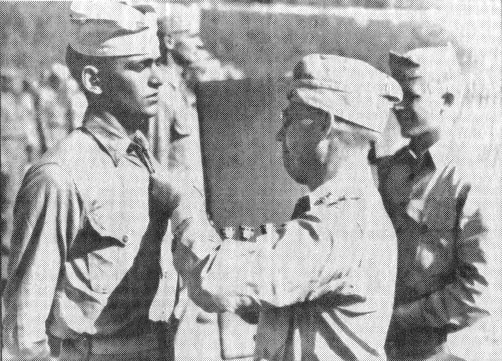
Kimball is awarded the Silver Star for actions
on Tinian.
Third Wave Arrives
to Find Dead and Dying
We landed on the reef, 800 to 1,000 yards out. We were in landing boats. As the ramp of our landing craft was lowered, our platoon leader, Lt. Lawson, ordered me and Pvt. "Slick" Edwards to help with the 37mm anti-tank gun. It had been assigned to our landing craft at the last minute, along with a corporal and a crew of two.
Seconds later, Lt. Lawson was hit. His body was torn in two. He died on the ramp.
Edwards the corporal and I started towards the beach in knee-high water with that damn gun.
On our left, the Third Platoon also had a 37mm gun in tow. Just as I glanced in that direction, there was a direct hit on their gun. Bodies flew in all directions, like in the movies. Then, only a few feet away, a Sherman tank was hit.
We arrived on the beach to an unbelieveable sight of death and destruction. It was a beach perhaps 10 to 12 feet deep with a log wall three to four feet high.
The first two waves were lying there, some of them alive. At my side, a naval hospital corpsman was holding a fellow Marine's chest. His heart was open to my sight. The corpman and Marine were covered with a bloody mess from head to toe. My forst thought was, "Why were they wearing red shirts and pants?"
Our sargeants began chanting, "Move or we'll all be dead."
In force, we stood up and moved over dead bodies and over the wall. Under heavy fire, we went across the airstrip into a series of bomb craters. I got behind some empty oil drums.
WHAM! A mortar shell hit me and the drums. My left side, knee and groin were hit. My left eardrum was busted. Three or four fellow Marines and I stayed put.
Minutes later, an officer with a Southern accent came on the scene. The remarkable thing about this man was that he was not wearing a helmet. He was a sight to behold. In Robert Sherrod's book, Tarawa, this officer was mentioned for having given his helmet to a Private who had lost his.
Seeing my wounds, the officer ordered me back to the beach. All this time, a fellow Marine was screaming my name. Why, I don't know, but to this day I still hear that voice, that scream.
I made it back to the beach. There were more bodies. A young, baby-faced Marine, the company runner, floated in the shallow water with many other, I will never forget that face.
A makeshift aid station was set up at 2nd Battalion headquarters. I was given first aid and was placed very near the battalion command post and Major Jim Crowe, who was in charge of the battalion. Later, he was an adviser for the John Wayne movie, "Sands of Iwo Jima."
He was unbelieveable. Because of my wounds, my pants had been torn open. He ordered a corpsman to cover my sunburned body with a poncho. That afternoon, as I lay on my back, I saw bodies floating in the water. High tide was coming in and the wounded and dead bodies were moving. Wounded were drowning in front of me.
In the mantime, the 3rd Battalion, 8th Regiment, was landing. Many, I later learned, drowned or had their landing craft blown up on the way in. Those who came ashore had death on their faces.
I was a "walking wounded." That night, I walked out to the pier - and to the landing boats that took us back to the USS Heywood. From there, I was taken to Hilo, Hawaii.
Within four weeks, we were back in combat training. Our next stop would be Saipan on June 15, 1944.
Kimball was wounded again at Saipan. Later he won a Silver Star at Tinian and a gold star (in lieu of a second Silver Star) at Okinawa.
Reprinted with permission.
Source: Tom Hennessey, "Remembering Tarawa," Press Telegram, 26 June 1988, p.7.